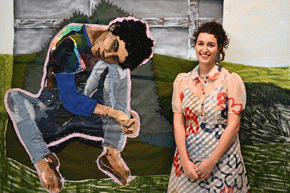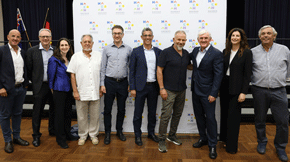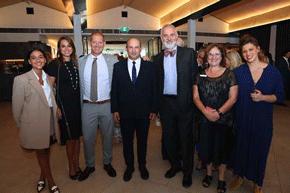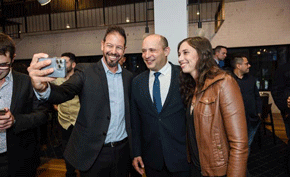Sir John Monash remembered
The Victorian Association of Jewish Ex-Servicemen and Women has held a graveside memorial service for one of Australia’s greatest military figures…the late Sir John Monash.
J-Wire reproduces the address by VAJEX president Ben Hirsh to those who gathered at Melbourne’s Brighton Cemetery to pay tribute to Monash who lies buried net to his wife Hannah.
“We are here to honor the memory of a great Australian, General Sir John Monash, the son of Jewish immigrants who, achieved fame by hard work and determination, not only as a leader on the battlefield in World War I, but as a nation builder who advanced the State of Victoria from 1920 until his death on 8th October 1931.
Born on 27th June 1865 in Dudley Street, West Melbourne, John Monash came equal dux at Scotch College and went on to Melbourne University where he graduated with a degree in engineering. He also graduated in Law which was to be very useful in his profession. Whilst employed as an engineer on construction around Melbourne, he was responsible for his part in the building of the Anderson Street Bridge over the Yarra River in 1899 and other projects. While still at Melbourne University he joined the Melbourne University Rifles as a Private. He later joined the Artillery and eventually commanded the North Melbourne Battery. In 1908 he was promoted to the rank of Lt-Colonel and given command of the Victorian Militia’s Intelligence Corps and in 1913, command of the 18th Infantry Brigade.
A year later John Monash was appointed Chief Censor and at outbreak of World War I, was given command of the 4th Infantry Brigade. In December sailed as Officer in Charge of the second convoy to the war.
He was in action with his Brigade on Gallipoli and was evacuated from the peninsula in December 1915. His commands were as GOC 3rd Division AIF in the rank of Major General, having participated in actions at Messines, Broodsneide and Passchendale.
His first Knighthood came in 1918 as a KCB and later as a GCMG. Promoted to Lt-General and appointed commander of the Australian Army Corps, Sir John Monash was instrumental in launching the great offensive of 8th August 1918, with five Australian Divisions, two Canadian, two New Zealand divisions and US troops. The offensive did not abate until victory over Germany was achieved on 11th November 1918.
His utmost consideration for the troops under his command surpassed that of any general of that time. His brilliant planning of battles not only brought success to the Allies but also minimised casualties, which we quite out of proportion at that time.
After the war ended, Sir John was put in charge of repatriating the Australian troops, a task he carried out as efficiently as his command of troops in the field. Returning home as a hero, Sir John Monash was appointed General Manager of the State Electricity Commission and later as its Chairman.
In 1930, he was promoted to the rank of General (4 star rating).
Sir John was also involved with the Shrine of Remembrance project which was dedicated in 1934. He held this position until his death on the 8th of October 1931, 79 years ago.
After laying in State at Parliament House Melbourne, a State Funeral was held for Sir John. It was estimated that between 250,000 and 300,000 people lined the streets of Melbourne to this very spot, to pay their last respects to a great Australian. His name lives on in many cities in Australia: Monash University, Monash Freeway; the City of Monash, the Monash Medical Centre in Clayton; as well as the city of Monash in South Australia – many streets in various Australian towns bear his name.
LEST WE FORGET
An item found on an internet site, quotes an American speaking of Sir John Monash:
“Yeah, he was a stud. He didn’t treat his troops like money to be spent. When I was in the United States Marine Corps, leaders had two basic concepts we focused on:
1. Mission Accomplishment, and
2. Troop welfare.
Monash did a great job with both.I would go so far as to say that there are likely thousands of Australians around today who might not be, had Monash not spared their great grandfathers from senseless slaughter.”
VAJEX committee member Harold Karpin added: ” The service was attended by two generals, Major General Jeffrey V Rosenfeld, CStJ VAJEX Patron and Major General MAJGEN David J McLachlan AO (Retd) R&SL State President
Mention was made that the smallish crowd was befitting the modest nature of Monash the man. It is hard to accept that at this same cometary 60,000 people mourned at General Monash’s graveside. It is unfortunate that many of today’s younger brigade seem to be distracted from honouring a man of whom they can and should be proud
Monash had many careers and was outstanding in all that he chose. He was a scholar who passed the matriculation examination at 14 becoming dux of Scotch College, Melbourne at 16. He graduated from the University of Melbourne, BA in 1887, Master of Science in Civil Engineering in 1893, Law in 1895 and Doctor of Engineering in 1921. He practiced law and was a highly regarded engineer and a number of Melbourne’s major bridges bear his name. He joined the Melbourne University Squadron in 1906 and it became apparent that his choice of a military career was to become his main and most important He was later to return to his ‘alma mater’, Melbourne University, as Vice Chancellor.
Fate was to decree that his rise up the commissioned ranks was to be stellar. He, with his brilliant ability for planning and his adjutant General Blamey’s brilliance in strategy, changed the course of warfare. He was a commander of so many decisive battles in which thousands of troops under his command were saved from being used as ‘gun fodder’. They, together, realised the benefit of providing their troops with armored coverage, rather than the strategy of in line and waves of troop advancement against enemy fire.
It is a little known fact that that General Monash was to become the only Australian to command American Forces and in August 1918 he was knighted as a Knight Commander of the Order of the Bath on the battlefield by King George V…the first time a British monarch had honored a commander in such a way in 200 years. By the end of the war Monash had acquired an outstanding reputation for intellect, personal magnetism, management and ingenuity. He also won the respect and loyalty of his troops.
At Sir John Monash’s state funeral, close to 250,000 mourners, paid their respects.
In a final act of humility, despite his achievements, honours and titles, he had left instructions that his tombstone simply bear the words “John Monash”. ”
Last month, the Victorian Association of Jewish Ex Servicemen and Women (VAJEX) organized a yahrtzeit grave side memorial service for Sgt Issy Smith, VC. Last Sunday, 10th October we payed tribute to an outstanding Jewish man and the highest ranking Australian Army commander; General Sir John Monash, by paying tribute at his graveside for his yahrtzeit service.













